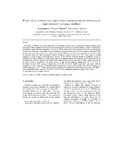Please use this identifier to cite or link to this item:
http://hdl.handle.net/10311/269Full metadata record
| DC Field | Value | Language |
|---|---|---|
| dc.contributor.author | Mphale, K.M. | |
| dc.contributor.author | Heron, M.L. | |
| dc.date.accessioned | 2009-02-10T12:55:39Z | |
| dc.date.available | 2009-02-10T12:55:39Z | |
| dc.date.issued | 2007 | |
| dc.identifier.citation | Mphale, K.M. et al (2007) Plant alkali content and radio wave communication efficiency in high intensity savanna wildfires, Journal of Atmospheric and Solar-Terrestrial Physics, Vol. 69, No. 4-5, pp. 471-484 | en |
| dc.identifier.issn | 1364-6826 | |
| dc.identifier.uri | http://hdl.handle.net/10311/269 | |
| dc.description.abstract | The flames of wildfires are weakly ionized gas. The ionization is mainly due to omnipresent alkali and alkaline earth metal species that are emitted from thermally decomposing plant structure into the flame during a wildfire. The amount of ionization in flames with alkali impurities is a factor of both the temperature and the quantity of the emitted alkali species in vegetation. Assuming a Maxwellian velocity distribution of flame particles and collision frequencies much higher than plasma frequencies, the propagation of radio waves through wildfires is predicted to have attenuation and phase shift. A theoretical model has been developed to predict propagation characteristics of HF–VHF radio signals at normal incidence to a high intensity wildfire fuel–flame interface. At the interface, the flame medium is modelled by a series of mini-slabs, each with a different but fixed electron density and dielectric permittivity governed by the Rayleigh distribution of temperature. Electron density in each mini-slab is calculated from thermal ionization of alkali species assuming the existence of thermal equilibrium. The model predicts average electron densities ranging from 10¹4 to 10¹7m–³ for fuel–flame interfaces with maximum temperatures from 900 to 1200 K. Specific attenuation and phase shift for propagation in the ionized gas are calculated from the predicted average electron density and collision frequency. At collision frequency of 10¹¹ s–¹, radio signal specific attenuation for the simulated grassfires range from 0.001 to 0.49 dBm–¹ while specific phase shift ranged from 0.0002 to 152°m–¹ for the maximum temperature range of 900–1150 K. | en |
| dc.language.iso | en | en |
| dc.publisher | Elsevier Science Ltd. www.elsevier.com/locate/jastp | en |
| dc.subject | Radiowave | en |
| dc.subject | Wildfire | en |
| dc.subject | Attenuation | en |
| dc.subject | Thermal ionization | en |
| dc.subject | Grassfire | en |
| dc.subject | Savanna | en |
| dc.title | Plant alkali content and radio wave communication efficiency in high intensity savanna wildfires | en |
| dc.type | Article | en |
| Appears in Collections: | Research articles (Dept of Physics) | |
Files in This Item:
| File | Description | Size | Format | |
|---|---|---|---|---|
| Mphale_JASTP69_2007.pdf | 2.21 MB | Adobe PDF |  View/Open |
Items in DSpace are protected by copyright, with all rights reserved, unless otherwise indicated.
